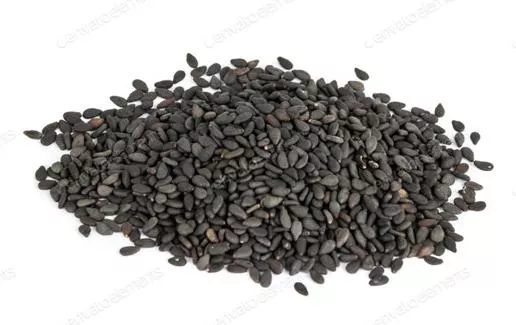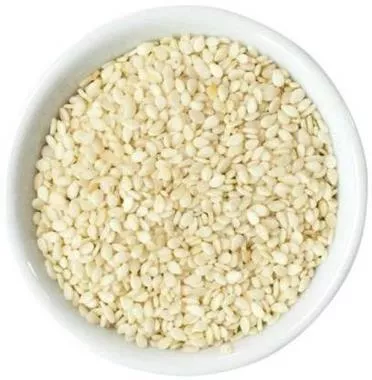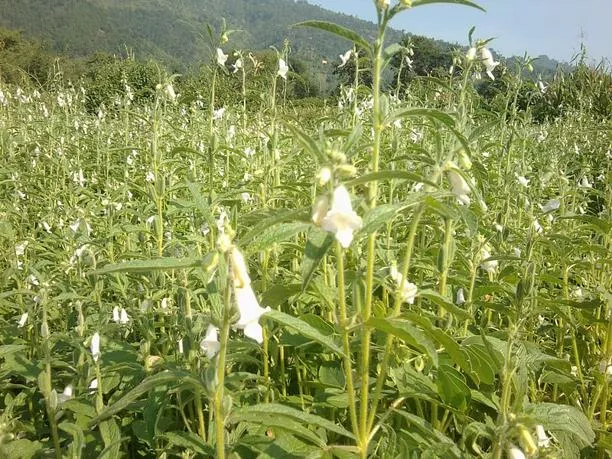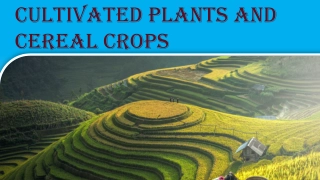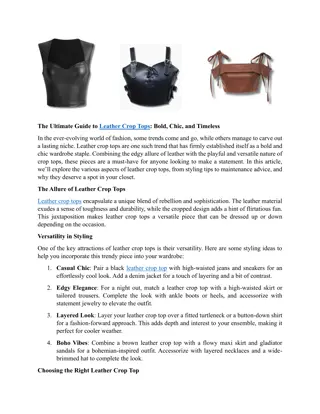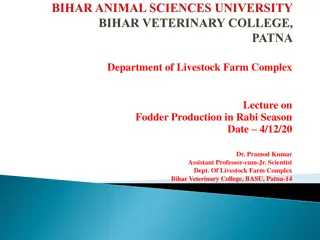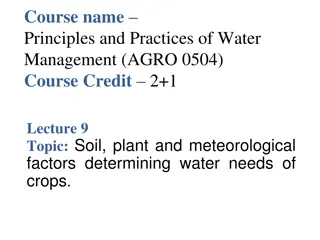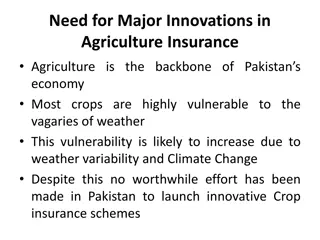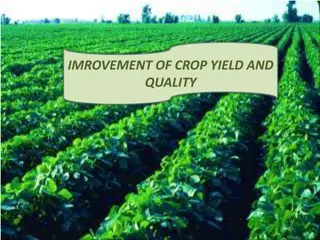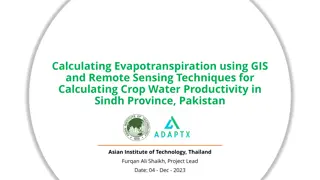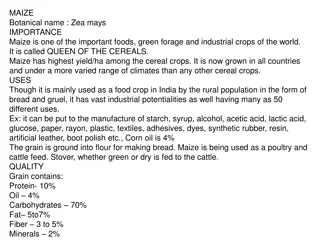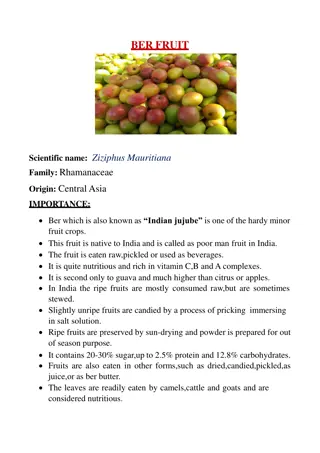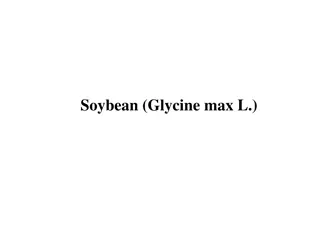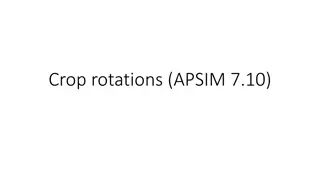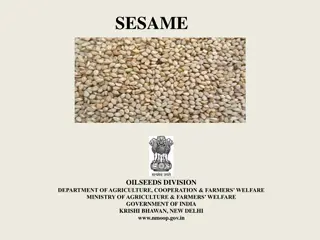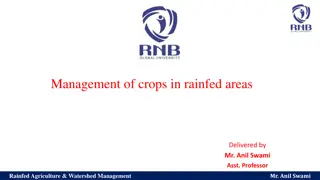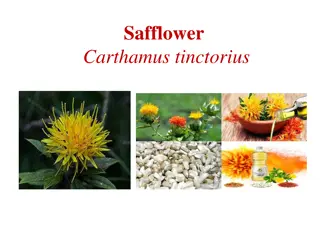Sesame: A Versatile Crop with Rich History and Economic Importance
Sesame, also known as Gingelly or Til, has deep roots in Indian culture and history, dating back to ancient texts. Cultivated for its high-quality oil and nutritious seeds, sesame finds diverse applications in cooking, medicine, cosmetics, and more. The byproducts like sesame cake are valued for their nutritional content and livestock feed. With its stable oil that resists rancidity, sesame holds economic significance and is exported globally. Originating in India, sesame continues to be a valuable crop in various regions, showcasing its adaptability and widespread cultivation.
Download Presentation

Please find below an Image/Link to download the presentation.
The content on the website is provided AS IS for your information and personal use only. It may not be sold, licensed, or shared on other websites without obtaining consent from the author. Download presentation by click this link. If you encounter any issues during the download, it is possible that the publisher has removed the file from their server.
E N D
Presentation Transcript
Sesamum (Sesamum indicum L.)
Sesamum is also known as Gingelly or Til Uses of sesamum: 1. It is associated with Indian culture 2. Cooking 3. Burning of lamps 4. Ingredient of medicines 5. Preparation of perfumed hair oil 6. Industrial purposes (Paints, soaps and insecticides)
Sesame name is mentioned in Atharvaveda, Ashtadvaiji, Manusmiti and puranas as Tila indicating the presence of sesame in India since the pre Christhian era. The word Taila , a Sanskrit word for oil is supposed to have delivered from Tila . In India, it is being grown by small and marginal farmers. The crop is now grown in wide range of environments, extending from the semi arid tropics and subtropics to temperate regions. The oil extracted from sesame is of high quality, resistant to oxidation and rancidity even when stored at ambient air temperature.
Economic importance: Sesame is cultivated for its seeds which contains 38-54% oil of high quality containing 18-25% protein. About 78% of sesame produced in India is used for oil extraction, culinary purpose, confectionery purpose and about 2-3% is retained for next sowing. Sesame is used as a food, as a flavouring agent and for medicinal purposes. The hull accounts for 15-20% of the whole seed and contains 2- 3% oxalic acid 1-2% calcium.. Dehulling and flavours characteristics of the meal and reduce the fiber content.
The hull of sesame oil produced in India is utilised for edible purposes. It is widely used in manufacturing of soaps, cosmetics, perfumes, insecticides and pharmaceutical product. Small quantity is used in the preparation of scented hair oil and also in therapy as a vehicle for the fat soluble medicines. The oil is used in the formulations of antacids, ointments, paints and varnishes. It is also used in insecticides sprays. Since this is highly stable and does not get rancid, it is blended with other oil to improve stability.
Sesame cake or meal obtained as a byproduct of the oil milling industry is rich in protein, vitamin (Niacin) and minerals (Ca, and P). The oil cake is highly extended on a livestock feed. It is also valid because of its methionine content. The cake is superior to solvent extractant cake. India exports sizable quantity of sesamum seeds to different countries.
Origin and History The cultivated species Sesamum indicum was originated in India, but in sub-Saharan areas many wild types of Sesamum are grown as natural vegatation. It must be spread from India to China, Thailand, Myanmar and Japan, while secondary centre of origin seems to be around Sudan, even though it as popularly grown in other African countries like Ethiopia, and Nigeria.
Distribution: Sesame is extensively cultivated in India, China, Myanmar, Sudan, Nigeria, Mexico and to a smaller extent is Ethiopia, Uganda, Venezuela, Turkey. India is the major sesame producing country for nearly 29% of the world s area and 26% of the world s production. In India, it is grown in an area of 1.46 m ha with production of 1.42 m tons. Gujarat alone accounts for 20% of total sesame production in India (3.78 lakh tons from 3.41 lakh hectares). Other states which produce sesame in India is UP, Orissa, MH, AP, Karnataka, TN and WB. Productivity is high in Karnataka and west Bengal (0.84 t/ha). Top five districts of Karnataka are Gulbarga (13026 ha), Koppal (14646 ha), Mandya (13554 ha), Mysore (11153 ha) and Bidar (81614 ha). Top five district producing sesame are Mysore- 11252 tons, Mandya-8447 tons, Gulbarga-5693 tons, Koppal-5244 tons, Davanagere-4167 tons.
Classification Sesamum is classified based on many criteria. Some of them are Based on seed colour: Plants with white colour seeds have less number of branches/ flowers and less yield whereas, plants with black colour seeds have more branches/ flowers and more yield. Based on maturity: Early maturity results in less number of branches/ flowers and less yield and late maturity results with more branches/ flowers and more yield. Based on the number of carpels: On the basis of numbers of carpels, it can be divided into two types Bicarpellatum with two carpels in flowers and Quadricarpellatum with four carpels in flowers.
Botanical description of plant There are many hundreds of varieties and species of S. indicum which differ considerably in size, growth, colour of flowers, seed size, colour and composition. Sesame is typically uneven branched annual, occasionally perennial 0.5 to 2m in height, with well developed root system, multiflowered, fruit is a capsule containing a number of small seeds. Sesamum has a tap root with profuse lateral branches. Late maturing types have well developed root system, while early matured have sparsely branched with well developed root system.
Stem: erect slightly hairs, flat shape, rectangular; smooth slightly hair or very hairy light green to purple in colour, height 1-1.5 m (some times 3m). Extent of branching is varietal character, Degree of branching is affected by environment, short stem with little branching is early maturity type. Lateral branched-late maturity. Leaves are variable in shape and size, lower leaves are branched, and margins are often toothed. Intermediate, some times are pubescent. Generally dull, darker green with occasionally yellow tint or bluish in colour. Alternate or opposite or mixed opposite- below, alternate-above.
Flowers: arise in axis of leaves, on the upper portion of the stem and branches. On the main shoot at which the first flower produced is a varietal character. Flowers single on the lower axis of leaves or multiple flowers on the upper branches. Sesame is cultivated as a self pollinated giving free seed set under isolation. However, the flowers attract insects and their activity lead to different rates of cross pollination reported few per cent to high as 65%. Fruit: is capsule, rectangular in section and deeply grooved with a minor triangular blade. Capsule length 2.5 t0 8 cm, diameter- 0.5 to 2.0 cm. No of loculi 4-12. Calsule dehiscence is splitting from top to bottom.
Seeds: Small, ovate flattened, testa with variable colour black, white, yellow, reddish brown, green, dark green, olive green. DM in seed increases most rapidly between 12 and 24 days. Capsule contains 50-100 or more seeds. Seed weight is 3 g/1000 seeds. The seeds mature in 4-6 weeks after fertilization.
Soil requirement: Sesame grows well on a wide range of soils from sandy soils to black cotton and clay soils but thrives well on well drained, moderately fertile subsoils of medium texture. Shallow soils with impervious sub soil are not suitable. It is grown on loamy soils in UP/MP, sandy soils in Rajasthan, black soils in Karnataka/ Maharashtra. Sandy soils produce poor growth due to low moisture. Soils with neutral pH are preferred. Slightly acidic/alkaline soils are also used (pH .5 to 8.0). Many soils grown with sesame are saline. Degree of tolerance to salinity varies with cultivars.
Climatic requirement It can be grown in between 250N to 250 S up to an altitude of 1500m. Ideal temperature ranges between 25-270C; it can tolerate temperature upto 180C and 400C. Low temperature may prone pollen sterility and flower drop. Continuous rains, water loggged situatios damage the crop. It can be grown with stored soil moisture in rabi or with scanty rainfall (up to 20-30 cm during growth) in kharif or under irrigation in summer. It is location specific and season specific crop. It is short day plant, but adjusts to varying day lengths
Land preperation: Sesame requires well pulverised seed bed with fine tilth for good germination of seed and establishment of desired plant stand. The soil is brought to fine tilth by deep ploughing in summer followed by planting. Tilth required for small grains like wheat is sufficient for sesame also. Land should be perfectly levelled to ensure that there is no waterlogging and land may be ridged to avoid drainage in those areas where high intensity rain is more common. For a crop, 2-3 harrowing followed by levelling is enough. All tillage operations should aim at weed free seed bed.
Varieties: Sesame is highly sensitive to seasonal variation in terms of day length for commercial cultivation and are location and seasonal specific Recommended varieties for different states: States AP Varieties Gauri Madhani Yield (kg/ha) 800 850 Duration (Days) 95-100 70-75 Oil content (%) 44 46 T-85 500 90-95 51 Rajeswari 900 80-85 50 Gujrath Gujrath Til-1 Mrug-1 550 500 85-90 85-90 51 53 Purva-1 400 120 50 Karnataka E-8 400 600 100 80 53 52 TMV-3 CO-1 - 90 50 TN TMV-3 TMV-4 560 650 80 85 52 52 TMV-5 400 75-80 54 TMV-6 700 85-90 54 C-O-1 730 90 5 SVPR-1 800 75-80 54
Time and sowing: In India, sesame is mostly grown in kharif season. In AP, Karnataka, MP, Maharashtra, Orissa and TN, it is grown both under kharif and rabi seasons. It is also grown as summer crop in Orissa, TN, Coastal AP, and Kerala under irrigation. It is grown both as pre kharif end kharif crop in WB. Generally high yields are recorded with sowing immediately after first rains in kharif. Very early sowing increases phyllody. Delayed sowing beyond mid July reduces yield in many places. Gujrath- Kharif-First week of June to second week of July, rabi/summer- January to February. Karnataka Northern regions (June-July), Southern region (April-May). AP- Coastal- Kharif-First fortnight of May, Summer- Second fortnight of January, Telangana-Kharif-Second fortnight of July. TN- Kharif- Second fortnight of May to Second fortnight of June, Rabi- November to December, Summer- Second fortnight of January to March.
Seed rate and sowing: Sesame is sown as broadcast as well as sown in rows. For broadcast crop, seed rate of 4-7 kg is adequate, for row crops 2.5 3 kg/ha. Spacing depends on growth habit and varieties, season and growing condition. AP- All seasons - 30x15 cm Gujrath- Kharif-45x10 cmRabi-45x15 cm Karnataka-30x15 cm TN- Kharif-22.5x22.5 cmRabi-30x30 cm. Thinning should be done to ensure recommended spacing within a row. First thinning should be done at 14 DAS, Second thinning should be done at 21 DAS.
Method of sowing: Farmers broadcast the seeds manually followed by hoeing to cover the seeds. Since seed size is small, the seeds should be mixed with sand or soil or with to increase the volume to handle and to adjust even distribution. Occasionally dry powdered manure and old seed that has lost viability is used. For row cropping seed drills may be used. The seeds should be placed shallow for germination. Normal depth of sowing is 2.5 cm.
Nutrient management: Sesame is generally grown on residual fertility in India. But to get good yields, it is essential that the crop is adequately fertilised. The average nutrient recommended to produce a ton of sesame is 51.7 kg N, 22.9 kg P2O5, 64 kg K2O, 11.7 kg S, 37.5 kg Ca, 15. Kg Mg, 118 g Zn, 793 g Fe, 115 g Mn and 117 g Cu. The level of nutrient depends on variety, season, soil fertlity status, previous crop, rainfall and moisture. Fertilizer affects plant growth. But they have little effect on seed composition or oil content. N application is linked to P availability in soils. When P is deficient N can depress the yield. N also affect seed oil content. N application vary between 20 and 80 kg /ha depending on the yield. It should be done at planting and if needed be top dressed before the first bud appears.
P is the most important especially under irrigated condition. It responds up to 40 kg. If the previous crop is supplied with large amount of P, sesame does not require any P application. Matured sesamum plant showed a high potassium content in capsules unless soils are diffident in K and application is not necessary. In soils low in K @ 15-30 kg/ha is recommended AP-Coastal-40-40-20, Telangana-30-30-20. Karnataka-37.5-25-25, TN-Irrigated-35-23-23, Rainfed- 25-15-15 Gujrath-Kharif-30-25-0, rabi-25-25-0 Rajasthan-High fertility-20-20-0, low fertility-40-25-0.
There are no records of minor element deficiency in sesame. Although it responds well to micronutrients like Zn. Sesame is sensitive to Boron. If toxicity occurs symptoms are showed with leaf margin burning. Fertilization contributes to 20-25% cost of cultivation. 50% N at planting and 50% at 30-35 DAS when adequate soil moisture is present. Under prolonged dry weather conditions foliar application of urea at 2% is economical and safe at all the crop growth stages. Application of 50% N + Azatobacter @ 100 g /ha was found to be as good as applying full dose as in TN. In India, it is generally recommended to incorporate 5-10 t FYM/ha at the time of land preparation.
Weed management: The slow initial growth of sesame seedlings make them poor competition to quick growing tropical weeds. Therefore the crop is sensitive to weed competition during the first 20-25 days. A weed free seed bed is most. Persistent /vigorous weeds must be controlled. These weeds grow very fast and smother the crop makes them to utilise soil moisture and applied fertiliser. Minimum of two weedings, one after 5 DAS and second at 20 DAS. Row crop can be weeded early with intercultural implements. Diuron-400-600 g/ha, Basalin-1 kg a.i./ha, Alachlor- 1.5 kg a. i. /ha, Fluchloralin 1.0 kg/ha as pre emergent application is recommended. Chemical weed control is resorted to only when weeds are severe and labours are scarce.
Water Management Sesamum is generally not irrigated, when grown in kharif or rabi seasons, altough 1-2 protective irrigation may help the crop in rainless period. But summer crop certainly needs to be irrigated once in 10-12 days, depending on the type of soil, preferably coinciding with critical stages, like flower initiation capsule filling stages. Its total water requirement is low (35-40 cm)
Harvesting and threshing: Sesame is ready for harvesting in 80-158 days. Generally in 100-110 days, but some cultivars matures in 70-75 days. It should be harvested when leaves turn yellow and start dropping while the capsules are still green. If harvesting is delayed there is loss of yields due to bursting and shattering of capsules. Capsules ripen irregularly from the lower stem upward. The drying before harvesting allows seed to ripen without loss. Plants are dried in sun and threshed manually. Threshing can also be done by turning the plants upright down and shaking or light beating on the floor. After thinning, the seeds are cleaned by winnowing. The introduction of non shattering varieties will allow mechanical harvesting, provided the crop is planted in large fields. Mechanised harvesting can be done with a reaper binding combine harvester.
Yield potential: The yield of sesame varies with season, method of cultivation and variety. Kharif-375-500 kg/ha Rabi-500-750 kg/ha Irrigation-900-1000kg/ha. Seeds should be dried to 5% moisture for safe storage.
Oil quality: Sesame is regarded as the queen of oilseeds bearing high oil content and excellent quality seed, oil. The chemical composition of seed is correlated with seed colour and hulling. constituents White seed Whole 5.4 50.4 19.8 3.2 11.9 4.8 1.72 1.06 4.47 Black variety Dehulled 6.1 53.3 21.5 1.3 14.9 2.6 0.06 0.06 0.6 Dehulled 8.2 54.1 25.1 1.4 14.7 2.3 0.20 0.19 0.18 Hulled 4.2 10.2 8.0 18.5 22.0 22.8 14.30 9.75 0.51 Moisture Fat Protein Crude fibre CHO Mineral Crude oil Ca P
Quality parameters Sesamum oil is well known for high stability under room temperature as well as frying temperaturew, due to its contents like sesamin (upto 0.6%) and sesamol. Sesamum is known as queen of oilseeds because of higher content of poly unsaturated fatty acids (PUFA). It is also rich in antioxidant Vitamin E. although, it contains higher PUFA, the oil is not prone to oxidative rancidity, like other oils with high PUFA, due to the presence of sesamin and sesamol. Its keeping quality under open conditions is highest among the edible oil seeds. Sesame oil is also rich in sulfur containing amino acids, besides containing 30% protein, obviously than black/brown seeds.
Pests and diseases Phyllody Phytopthora blight Bacterial blight Leraf spot Leaf curl Leaf roller and capusule borer Jassids Bihar hairy caterpillar
Anti- nutritional factors Some people are allergic to thr use of sesame oil, which may develop many allergic reactions including anaphylaxis.
Crop sequence: AP- Groundnut-sesame, sesame-upland rice, sesame- horse gram, sesame-finger millet, sesame-sugarcane. Gujarath- Sesame-mustard, pearl millet-sesame, Karnataka- sesame-horse gram, sesame-chickpea, rice- sesame, TN- rice-sesame, groundnut- sesame, sesame-soybean.
Intercropping: Yield and monitory returns from sesame are more when it is raised as pure crop rather than as mixed/intercrop. Karnataka - sesame + groundnut (1:1), sesame + pigeonpea/sesame+ castor/ sesame+ pearl millet/ sesame + moong bean (8: 2), sesame + chickpea (8:2) Gujarat sesame + soybean (3:1), sesame + pigeonpea/ sesame + castor (3:1), sesame + cotton (3:1), sesame + sunflower (3:1) TN sesame + moong bean (8:2), sesame + chickpea (8;2), sesame + cotton/castor/pearlmillet/pigeonpea.




